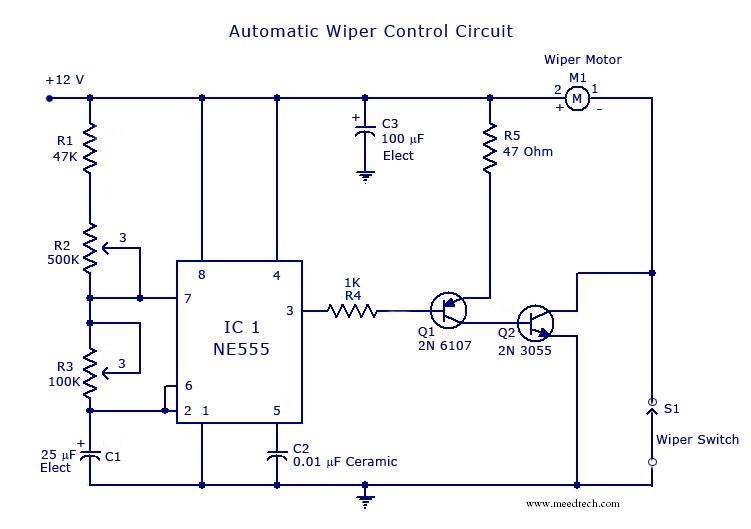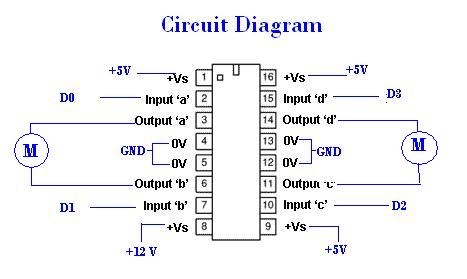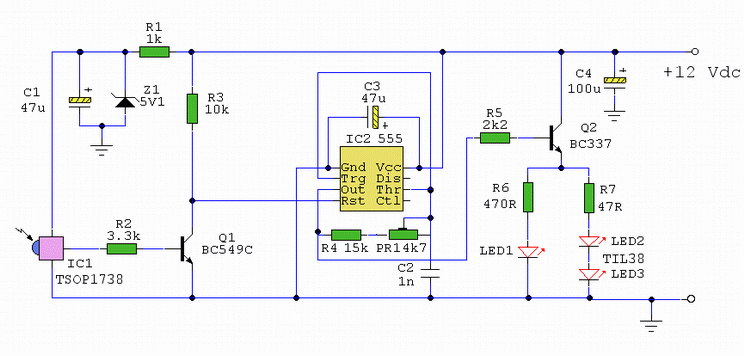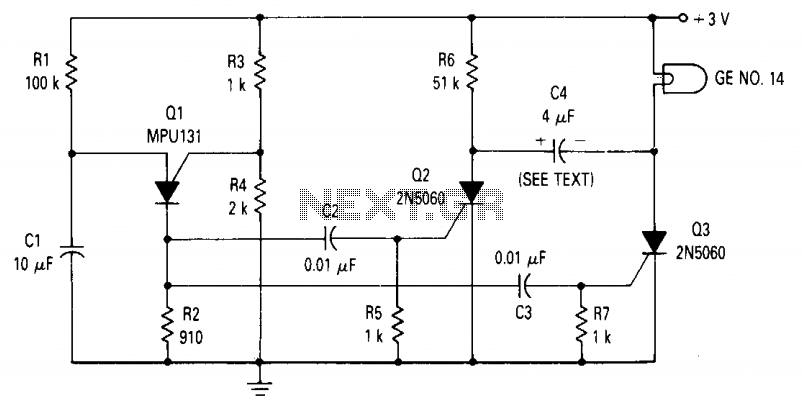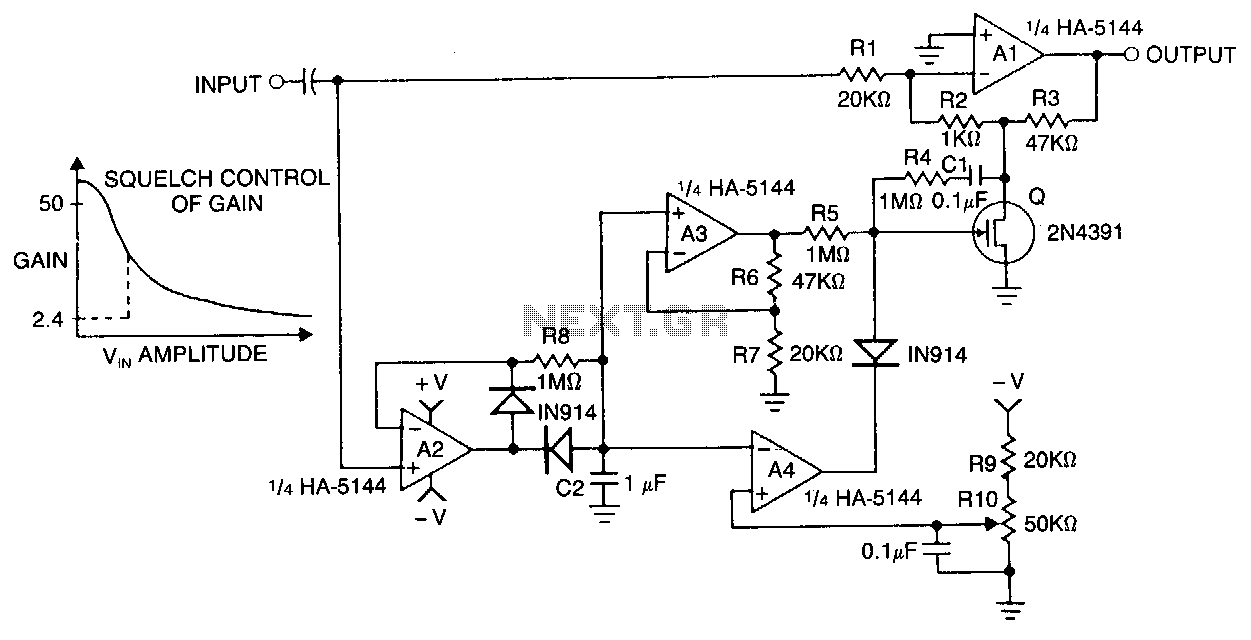
Beam-break Detector For Camera Shutter or Flash Control
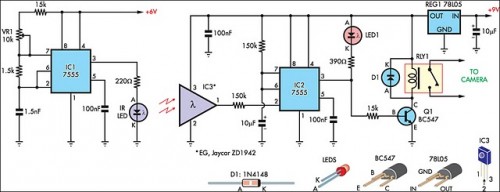
The IR detector (IC3) controls an LM 7555 CMOS timer (IC2) operating in monostable mode. When the beam is interrupted, IC2 is triggered, and its pin 3 output goes high for approximately half a second. This action extinguishes LED1 and activates transistor Q1 to drive a 5V low-power relay.
The circuit utilizes an infrared (IR) detector, designated as IC3, which serves as the primary sensing element. This detector is typically configured to emit and receive infrared light, establishing an invisible beam. When an object interrupts this beam, the detector signals the LM 7555 timer (IC2), which is set up in monostable mode. In this configuration, the timer is triggered by a rising edge on its input pin, which in this instance is connected to the output of the IR detector.
Upon activation, IC2's output at pin 3 transitions to a high state for a duration determined by external timing components, typically a resistor and capacitor connected to the timer. In this design, the output remains high for about half a second, during which it performs two critical functions. First, it extinguishes LED1, which may serve as an indicator light in the system, signaling that the beam has been broken. Second, the high output activates transistor Q1.
Transistor Q1 acts as a switch, controlling the current flow to a low-power relay designed to operate at 5V. When Q1 is turned on, it allows current to flow through the relay coil, causing the relay to engage and close its contacts. This action can be used to control higher power devices or circuits, providing a practical means of implementing a response to the interruption of the IR beam.
The overall functionality of this circuit is well-suited for applications such as intrusion detection systems, automated door openers, or any scenario requiring a non-contact sensing method to trigger an action based on the presence or absence of an object. The combination of the IR detector, timer, and relay provides a robust solution for various electronic control tasks.The IR detector (IC3) controls an LM 7555 CMOS timer (IC2) which operates in mono stable mode. When the beam is broken, IC2 is triggered and its pin 3 output goes high for about half a second. This extinguishes LED1 and turns on transistor Q1 to drive a 5V low-power relay 🔗 External reference
The circuit utilizes an infrared (IR) detector, designated as IC3, which serves as the primary sensing element. This detector is typically configured to emit and receive infrared light, establishing an invisible beam. When an object interrupts this beam, the detector signals the LM 7555 timer (IC2), which is set up in monostable mode. In this configuration, the timer is triggered by a rising edge on its input pin, which in this instance is connected to the output of the IR detector.
Upon activation, IC2's output at pin 3 transitions to a high state for a duration determined by external timing components, typically a resistor and capacitor connected to the timer. In this design, the output remains high for about half a second, during which it performs two critical functions. First, it extinguishes LED1, which may serve as an indicator light in the system, signaling that the beam has been broken. Second, the high output activates transistor Q1.
Transistor Q1 acts as a switch, controlling the current flow to a low-power relay designed to operate at 5V. When Q1 is turned on, it allows current to flow through the relay coil, causing the relay to engage and close its contacts. This action can be used to control higher power devices or circuits, providing a practical means of implementing a response to the interruption of the IR beam.
The overall functionality of this circuit is well-suited for applications such as intrusion detection systems, automated door openers, or any scenario requiring a non-contact sensing method to trigger an action based on the presence or absence of an object. The combination of the IR detector, timer, and relay provides a robust solution for various electronic control tasks.The IR detector (IC3) controls an LM 7555 CMOS timer (IC2) which operates in mono stable mode. When the beam is broken, IC2 is triggered and its pin 3 output goes high for about half a second. This extinguishes LED1 and turns on transistor Q1 to drive a 5V low-power relay 🔗 External reference
Warning: include(partials/cookie-banner.php): Failed to open stream: Permission denied in /var/www/html/nextgr/view-circuit.php on line 713
Warning: include(): Failed opening 'partials/cookie-banner.php' for inclusion (include_path='.:/usr/share/php') in /var/www/html/nextgr/view-circuit.php on line 713
